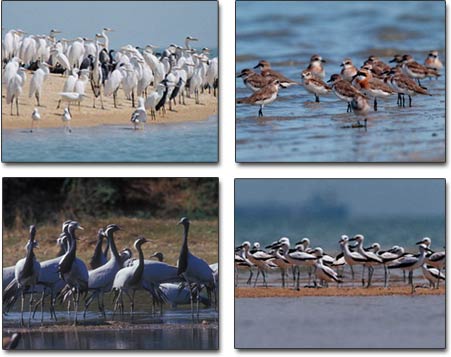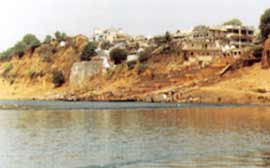| Vijay Vilas Palace | |||||||||||||
| |||||||||||||
|
Friday, December 31, 2010
Vijay Vilas Palace
The House of Mangaldas Girdhardas
| |||
| | |||
| |||
Thursday, December 30, 2010
RAM CHANT IN JAMNAGAR
For Hindus Ram Chant gives release from all the problems and difficulties they come across. It is said that Ram Chant is sweeter than the sweetest, bestowing the best for the Ram Devotees.
In Jamnagar, Gujarat, Sri Bala Hanuman temple constructed 44 years back, Ram Chanting that started on August 1, 1964 that is for 44 years and is still continuing without interruption even during natural calamities. In the past 44 years, 23,140,800 minutes the chanting is continuing and may continue eternally.
The continuous Rama Chant has already entered into Guinnes Book of Word Record already twice.
The famous Rama Chanting SRI RAMA JAYA RAMA JAYA JAYA RAMA has entered its 45 th year on 1st August 2008 and continue for many more years and even hundreds of years.
A Home for Nature Lovers
| |||
| | |||
| |||
Hotel Nilambag Palace
| |||
| | |||
| |||
Institute of Indology
| Institute of Indology | |||||||||||||
| |||||||||||||
|
Wednesday, December 29, 2010
Darbargadh Poshina
| |||
| | |||
| |||
Riverside Palace / Orchard Palac
| |||
| | |||
| |||
Tuesday, December 28, 2010
The Vijay Vilas Palace Hotels & Resorts
| |||
| | |||
| |||
The Rajmahal Palace
| |||
| | |||
| |||
Monday, December 27, 2010
Khijadia Bird Sanctuary
Khijadia Bird Sanctuary
This place which witnesses the blending of sea water and fresh water was declared a sanctuary on the 6th November 1982.Earlier there was a Dam which stored fresh water. Over the years, geographical variations resulted in the formation of a unique type of land amidst the blend of sea and river water.
Depending on the water type two different varieties of vegetation started growing here inviting wildlife. Birds and animals started flocking this area and dwelling here. The sanctuary spans an area of 605 hectares.
Jasdan:
(47 Kms from Gondal) the great warrior clan of Khachar Kathis ruled the house of Jasdan. They founded the fortified town of Jasdan on the banks of Bhadar River.
 The Darbargadh at Jasdan is a beautiful example combining plaster decoration with intricate wrought iron work. The decoration above the arches and 'jharokhas' are noteworthy. Hingolgadh Nature Education Sanctuary in the vicinity of Jasdan is a creation of the nature loving rulers of Jasdan. Here, nature education camps are organized to create awareness about wildlife and environment. The royal palace on the hilltop is now a heritage hotel, offering a nice and comfortable stay amidst natural surroundings.
The Darbargadh at Jasdan is a beautiful example combining plaster decoration with intricate wrought iron work. The decoration above the arches and 'jharokhas' are noteworthy. Hingolgadh Nature Education Sanctuary in the vicinity of Jasdan is a creation of the nature loving rulers of Jasdan. Here, nature education camps are organized to create awareness about wildlife and environment. The royal palace on the hilltop is now a heritage hotel, offering a nice and comfortable stay amidst natural surroundings.
| |||
| | |||
| | |||
| |||
Mundra
| Mundra | |||||||||||||
| |||||||||||||
|
Sunday, December 26, 2010
Kutiyana:
(53 km from Dhoraji)
 Kutiyana is located on the banks of river Bhadar. Before independence, Kutiyana was under the rule of the Junagadh Nawabs. Rich traders of the Memon community, before independence inhabited the town. The houses of Kutiyana reflect the high aesthetic taste of Memon Muslims. Kutiyana is a well-planned town with a central main bazaar street leading to a magnificent mosque with high minarets and impressive façade. The shops at lower level of arcade form an urban edge. The courtyards within the water tank for 'vazu' and the profusely plaster-decorated architectural elements, painted in yellows, greens and blues make it a perfect representative example of mosque architecture of the late 19th century.
Kutiyana is located on the banks of river Bhadar. Before independence, Kutiyana was under the rule of the Junagadh Nawabs. Rich traders of the Memon community, before independence inhabited the town. The houses of Kutiyana reflect the high aesthetic taste of Memon Muslims. Kutiyana is a well-planned town with a central main bazaar street leading to a magnificent mosque with high minarets and impressive façade. The shops at lower level of arcade form an urban edge. The courtyards within the water tank for 'vazu' and the profusely plaster-decorated architectural elements, painted in yellows, greens and blues make it a perfect representative example of mosque architecture of the late 19th century.
Chandod
(22km from Dabhoi) this picturesque town on the bank of the Narmada, at the confluence of three rivers: Narmada, Orsang and Gupta Saraswati, is an ancient seat of Sanskrit learning for Brahmins.
 The 'ghats' leading to the pure waters of Narmada and the temples, make it a sacred place for Hindus performing the rituals after death. Mandvi Mahal, a haveli of the Mahida Rajputs, dating back to the late 19th century, is now a heritage hotel. It is located close to river Narmada, in a serene setting. The 'haveli' offers a picturesque vista of bathing 'ghats', temples with fine carvings and the aquatic life on the river.
The 'ghats' leading to the pure waters of Narmada and the temples, make it a sacred place for Hindus performing the rituals after death. Mandvi Mahal, a haveli of the Mahida Rajputs, dating back to the late 19th century, is now a heritage hotel. It is located close to river Narmada, in a serene setting. The 'haveli' offers a picturesque vista of bathing 'ghats', temples with fine carvings and the aquatic life on the river.
Navjivan Nature Cure Centre
| Navjivan Nature Cure Centre | |||||||||||||
| |||||||||||||
|
Kera
| Kera | |||||||||||||
| |||||||||||||
|
Beyt Dwarka
| Beyt Dwarka | |||||||||||||
| |||||||||||||
|
Ranmal Lake
| Ranmal Lake | |||||||||||||
| |||||||||||||
|
Saturday, December 25, 2010
SHRI MANIBHADRAVEER DERASAR, MAGARWADA
Magarwada, in the Vadgam taluka at a distance of 18 kms from Palanpur owes its importance to being one of the three centres of Manibhadraveer. The other two are Ujjain and Aklod.
Manibhadraveer, as the legend goes, was born in his previous birth in Ujjain as Manekshaw. He was a staunch Jain Shravak whose Guru was Maharaj Hemvimal Suriji. During his chaturmas in Agra, Manekshaw was deeply influenced by his Guru's discourses on the sacredness and importance of Shatrunjay. Due to this, he decided to undertake the arduous penance of going on foot to Shatrunjay to do the Navanuni Yatra and end it with a 2-day fast under the Ryan tree.

With his Guru's blessings, he set off on the auspicious day of Kartiki Poonam. When he was close to present day Magarwada, a gang of dacoits attacked and killed him, severing his head, arms and lower body. Manekshaw, who was totally absorbed in his Navkar mantra jaap and the sacredness of Shatrunjay, was reborn as Indra of Manibhadraveerdev.

Meanwhile, his Guru's disciples were facing many difficulties because of the Bhairvos. According to the Dev vaani, his Guru came to Magarwada, and sat down in Dhyan to overcome these difficulties. That is when Manibhadraveer decided to help his Guru to overcome the obstacles caused by the Bhairvos. He subdued them. His Guru honoured him by installing a 'pind' of his legs in Magarwada on Maha Sud Pancham day and constructed the temple there.
Today, people flock to Magarwada in large numbers to pray to Manibhadraveer to solve their problems and help them overcome their obstacles.
Traditionally, all Palanpuri Deravasi Kotharis need to go to Magarwada before their wedding, to pay their respects to the Adishtai Dev - Shri Manibhadraveer. This 'mahet' ritual is strictly adhered to by most families even today
Northwest Kutch
| | |||||||||||||
| |||||||||||||
|
Mandvi - Kutch gate
| Mandvi - Kutch | |||||||||||||
| |||||||||||||
|
Solarium

Solarium is a one of its kind structure in entire Asia. It is also known as Ranjit Institute of Poly-Radio Therapy and is mainly known for the treatment of skin diseases. It is a revolving tower which provides full daylong sunlight for the treatment. It was built by Jam Shri Ranjitsinhji with the help of an expert from France.
Friday, December 24, 2010
Dholavira
| | |||||||||||||
| |||||||||||||
|
































